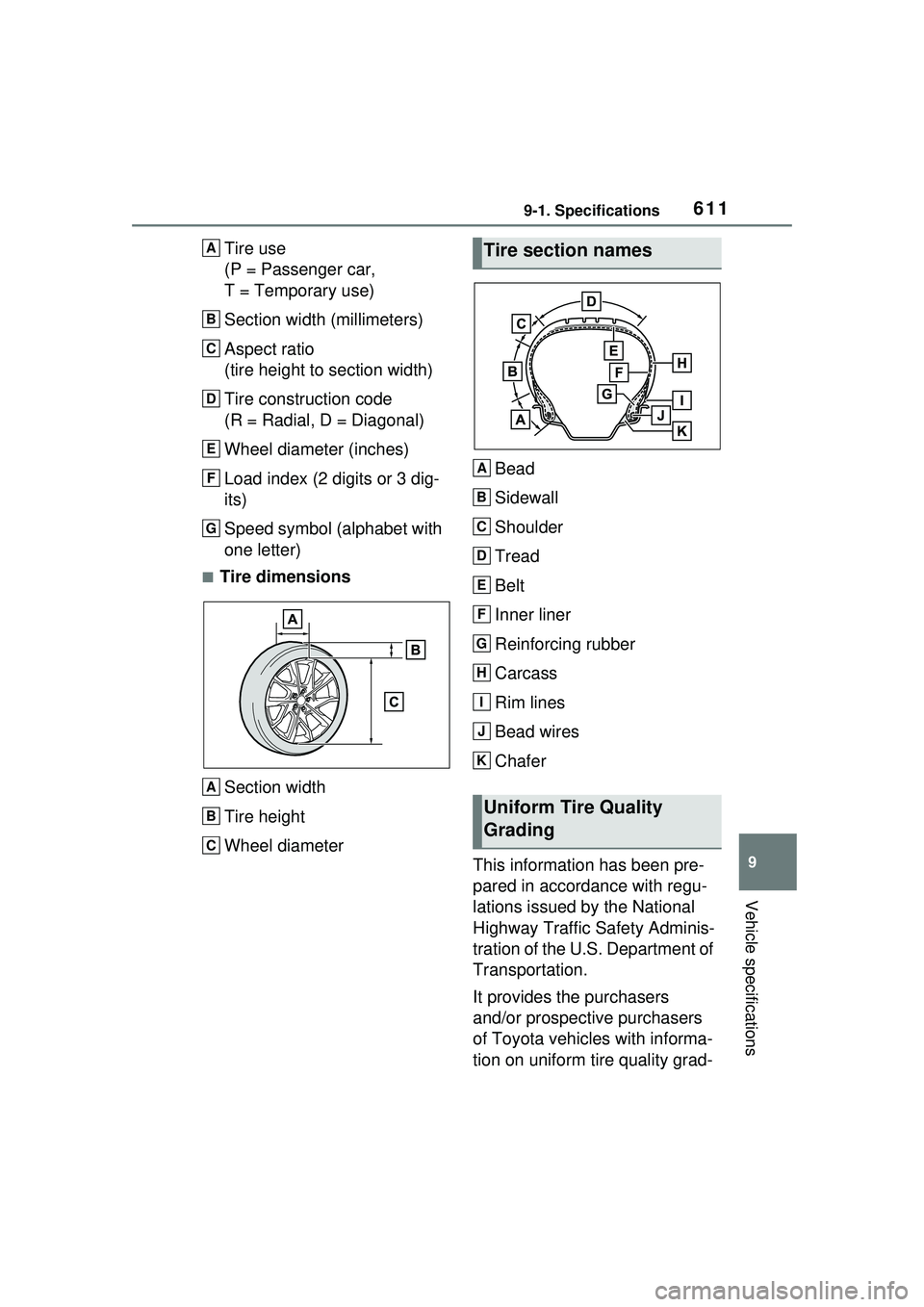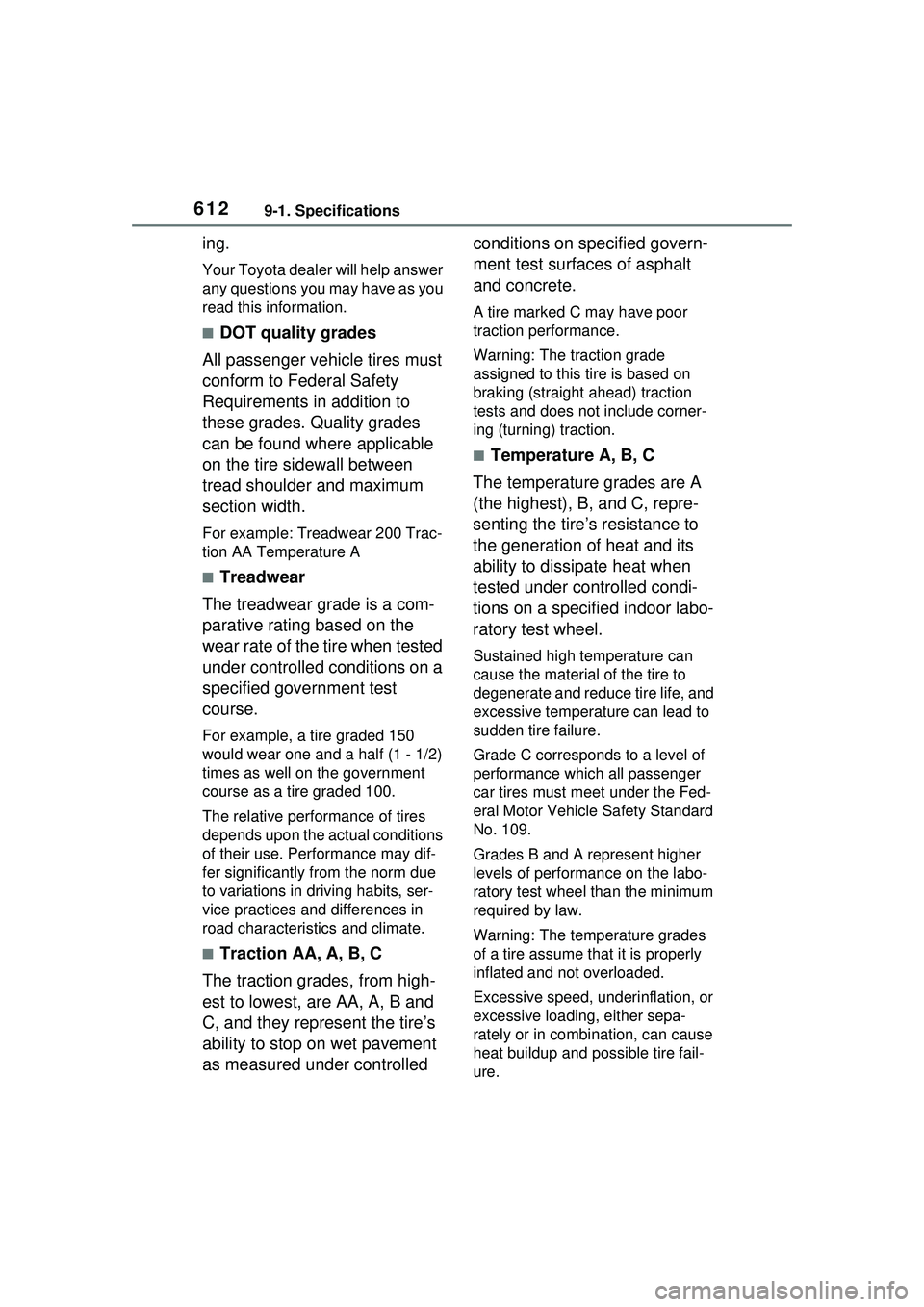2023 TOYOTA PRIUS PRIME wheel
[x] Cancel search: wheelPage 606 of 680

6069-1. Specifications
Vehicles with 19-inch tires
Tire size195/50R19 88H
Tire inflation pressure (Recom-
mended cold tire inflation pres-
sure)
Front:
35 psi (240 kPa, 2.4 kgf/cm
2 or bar)
Rear:
33 psi (230 kPa, 2.3 kgf/cm
2 or bar)
Spare:
None
Driving at high speeds (above 100 mph
[160 km/h]) (in countries where such
speeds are permitted by law):
Add 3 psi (20 kPa, 0.2 kgf/cm
2 or bar) to
the front tires and rear tires.
Never exceed the maximum cold tire infla-
tion pressure indicated on the tire sidewall.
Wheel size19 6 1/2J
Wheel nut torque76 ft•lbf (103 N•m, 10.5 kgf•m)
Page 611 of 680

6119-1. Specifications
9
Vehicle specifications
Tire use
(P = Passenger car,
T = Temporary use)
Section width (millimeters)
Aspect ratio
(tire height to section width)
Tire construction code
(R = Radial, D = Diagonal)
Wheel diameter (inches)
Load index (2 digits or 3 dig-
its)
Speed symbol (alphabet with
one letter)
■Tire dimensionsSection width
Tire height
Wheel diameter Bead
Sidewall
Shoulder
Tread
Belt
Inner liner
Reinforcing rubber
Carcass
Rim lines
Bead wires
Chafer
This information has been pre-
pared in accordance with regu-
lations issued by the National
Highway Traffic Safety Adminis-
tration of the U.S. Department of
Transportation.
It provides the purchasers
and/or prospective purchasers
of Toyota vehicles with informa-
tion on uniform tire quality grad-
A
B
C
D
E
F
G
A
B
C
Tire section names
Uniform Tire Quality
Grading
A
B
C
D
E
F
G
H
I
J
K
Page 612 of 680

6129-1. Specifications
ing.
Your Toyota dealer will help answer
any questions you may have as you
read this information.
■DOT quality grades
All passenger vehicle tires must
conform to Federal Safety
Requirements in addition to
these grades. Quality grades
can be found where applicable
on the tire sidewall between
tread shoulder and maximum
section width.
For example: Treadwear 200 Trac-
tion AA Temperature A
■Treadwear
The treadwear grade is a com-
parative rating based on the
wear rate of the tire when tested
under controlled conditions on a
specified government test
course.
For example, a tire graded 150
would wear one and a half (1 - 1/2)
times as well on the government
course as a tire graded 100.
The relative performance of tires
depends upon the actual conditions
of their use. Performance may dif-
fer significantly from the norm due
to variations in driving habits, ser-
vice practices and differences in
road characteristics and climate.
■Traction AA, A, B, C
The traction grades, from high-
est to lowest, are AA, A, B and
C, and they represent the tire’s
ability to stop on wet pavement
as measured under controlled conditions on specified govern-
ment test surfaces of asphalt
and concrete.
A tire marked C may have poor
traction performance.
Warning: The traction grade
assigned to this tire is based on
braking (straight ahead) traction
tests and does not include corner-
ing (turning) traction.
■Temperature A, B, C
The temperature grades are A
(the highest), B, and C, repre-
senting the tire’s resistance to
the generation of heat and its
ability to dissipate heat when
tested under controlled condi-
tions on a specified indoor labo-
ratory test wheel.
Sustained high temperature can
cause the material of the tire to
degenerate and reduce tire life, and
excessive temperature can lead to
sudden tire failure.
Grade C corresponds to a level of
performance which all passenger
car tires must meet under the Fed-
eral Motor Vehicle Safety Standard
No. 109.
Grades B and A represent higher
levels of performance on the labo-
ratory test wheel than the minimum
required by law.
Warning: The temperature grades
of a tire assume that it is properly
inflated and not overloaded.
Excessive speed, underinflation, or
excessive loading, either sepa-
rately or in combination, can cause
heat buildup and possible tire fail-
ure.
Page 614 of 680

6149-1. Specifications
RimA metal support for a tire or a tire and tube
assembly upon which the tire beads are seated
Rim diameter
(Wheel diameter)Nominal diameter of the bead seat
Rim size designationRim diameter and width
Rim type designationThe industry manufacturer’s designation for a
rim by style or code
Rim widthNominal distance between rim flanges
Vehicle capacity weight
(Total load capacity)The rated cargo and luggage load plus 150 lb.
(68 kg) times the vehicle’s designated seating
capacity
Vehicle maximum load on
the tireThe load on an individual tire that is determined
by distributing to each axle its share of the max-
imum loaded vehicle weight, and dividing by two
Vehicle normal load on
the tire
The load on an individual tire that is determined
by distributing to each axle its share of curb
weight, accessory weight, and normal occupant
weight (distribut ed in accordance with Table 1
*
below), and dividing by two
Weather sideThe surface area of the rim not covered by the
inflated tire
Bead
The part of the tire that is made of steel wires,
wrapped or reinforced by ply cords and that is
shaped to fit the rim
Bead separationA breakdown of the bond between components
in the bead
Bias ply tire
A pneumatic tire in which the ply cords that
extend to the beads are laid at alternate angles
substantially less than 90 degrees to the center-
line of the tread
CarcassThe tire structure, except tread and sidewall
rubber which, when inflated, bears the load
ChunkingThe breaking away of pieces of the tread or
sidewall
CordThe strands forming the plies in the tire
Tire related termMeaning
Page 616 of 680

6169-1. Specifications
Measuring rimThe rim on which a tire is fitted for physical
dimension requirements
Open spliceAny parting at any junction of tread, sidewall, or
innerliner that extends to cord material
Outer diameterThe overall diameter of an inflated new tire
Overall width
The linear distance between the exteriors of the
sidewalls of an inflated ti re, including elevations
due to labeling, decorations, or protective bands
or ribs
Passenger car tire
A tire intended for use on passenger cars, multi-
purpose passenger vehicles, and trucks, that
have a gross vehicle weight rating (GVWR) of
10,000 lb. or less.
PlyA layer of rubber-coated parallel cords
Ply separationA parting of rubber compound between adjacent
plies
Pneumatic tire
A mechanical device made of rubber, chemi-
cals, fabric and steel or other materials, that,
when mounted on an automotive wheel, pro-
vides the traction and contains the gas or fluid
that sustains the load
Radial ply tire
A pneumatic tire in which the ply cords that
extend to the beads are laid at substantially 90
degrees to the centerline of the tread
Reinforced tire
A tire designed to operate at higher loads and at
higher inflation pressures than the correspond-
ing standard tire
Section width
The linear distance between the exteriors of the
sidewalls of an inflated tire, excluding elevations
due to labeling, decoratio n, or protective bands
SidewallThat portion of a tire between the tread and
bead
Sidewall separationThe parting of the rubber compound from the
cord material in the sidewall
Tire related termMeaning
Page 617 of 680

6179-1. Specifications
9
Vehicle specifications
*: Table 1 Occupant loading and distributio n for vehicle normal load for
various designated seating capacities
Snow tire
A tire that attains a traction index equal to or
greater than 110, compared to the ASTM E-
1136 Standard Reference Test Tire, when using
the snow traction test as described in ASTM F-
1805-00, Standard Test Method for Single
Wheel Driving Traction in a Straight Line on
Snow-and Ice-Covered Surfaces, and which is
marked with an Alpine Symbol ( ) on at least
one sidewall
Test rim
The rim on which a tire is fitted for testing, and
may be any rim listed as appropriate for use
with that tire
TreadThat portion of a tire that comes into contact
with the road
Tread ribA tread section running circumferentially around
a tire
Tread separationPulling away of the tread from the tire carcass
Treadwear indicators
(TWI)The projections within the principal grooves
designed to give a visual indication of the
degrees of wear of the tread
Wheel-holding fixtureThe fixture used to hold the wheel and tire
assembly securely during testing
Designated seating
capacity, Number of occupantsVehicle normal load,
Number of occupantsOccupant distribution in a normally loaded vehi- cle
2 through 422 in front
5 through 1032 in front, 1 in second seat
11 through 155
2 in front, 1 in second
seat, 1 in third seat, 1 in fourth seat
16 through 207
2 in front, 2 in second
seat, 2 in third seat, 1 in fourth seat
Tire related termMeaning
Page 632 of 680

6329-2. Customization
*: If equipped
■Driving mode select switch (P.422)
■Automatic air conditioning system ( P.434)
*: This setting changes in accordance with My Settings.
■Illumination ( P.446)
Rear accessory settingOff
3.9 in. (10 cm)
O7.9 in. (20 cm)
11.8 in. (30 cm)
15.7 in. (40 cm)
Clear registered parking
space--O
FunctionDefault settingCustomized
setting
Powertrain control in cus-
tom modeNormalSportOEco
Steering wheel control in
custom modeNormalSportO
Air conditioning operation
in custom modeNormalEcoO
FunctionDefault settingCustomized setting
A/C auto switch operation*OnOffOO
FunctionDefault settingCustomized setting
Time elapsed before the
interior lights turn off
*115 seconds
Off
OO7.5 seconds
30 seconds
Operation after the power
switch is turned offOnOffO
FunctionDefault settingCustomized settingABC
ABC
ABC
ABC
Page 651 of 680

Alphabetical Index651
Automatic door locking and unlocking systems ............... 190
Automatic High Beam (AHB) . 272
Automatic light control system ............................................... 270
Average fuel economy ........... 163
Average vehicle speed .......... 163
B
Back door ................................ 191 Power back door .................. 194
Wireless remote control ....... 194
Back-up lights Replacing exterior lights ....... 543
Battery (12-volt battery) ......... 511 Checking the battery condition........................................... 513
If the 12-volt battery is dis- charged .............................. 589
Preparing and checking before winter.................................. 429
Replacing ............................. 591
Warning light ........................ 555
Battery (traction battery) ......... 83 Charging....................... 108, 116
Location.................................. 83
Specification ......................... 602
Blind Spot Monitor (BSM) ...... 354
Bottle holders ......................... 452
Brake Brake Hold ........................... 266
Fluid ..................................... 509
Parking brake ....................... 263
Regenerative braking ............. 78
Warning light ........................ 555
Brake assist ............................ 424
Brake Hold .............................. 266
Brake Override System .......... 240
Break-in tips ........................... 240
Brightness control Instrument panel light control160
BSM (Blind Spot Monitor) ...... 354
C
Care..................................486, 490 Aluminum wheels .................486
Exterior .................................486
Interior ..................................490
Seat belts .............................490
Cargo capacity ................246, 249
Cargo hooks............................454
Catch protection function Power windows ....................227
Chains......................................431
Charging ..........................108, 116 “My Room Mode” ..................134
AC charging cable ..................97
Charging equipment ...............94
Charging indicator ..................96
Charging messages .............143
Charging precautions ...........120
Charging procedure..............116
Charging schedule function ..123
Charging time may increase.114
High voltage components .......83
How to charge ......................116
Information related to charging display ................................111
Opening and closing the charging port lid ....................94
Power sources precautions ..107
Power sources that can be used ...........................................106
Safety functions ....................113
Solar charging system ..........136
When charging cannot be car- ried out ...............................139
Charging port ............................94 Opening and closing...............94
Child-protector lock ...............189
Child restraint system ..............51 Fixed with a LATCH system ...60
Fixed with a seat belt..............55
Front passenger occupant clas-